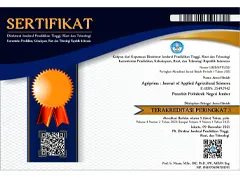Pengaruh Aplikasi Abu Terbang dan Pupuk Kotoran Sapi terhadap Populasi Mikroorganisme di Tanah Ultisol
DOI:
10.25047/agriprima.v5i1.406Downloads
Abstract
Ultisol tergolong tanah kering masam yang paling luas di Indonesia tetapi minim dimanfaatkan untuk bidang pertanian. Hal ini karena kandungan Al yang tinggi, kurangnya unsur hara, dan rendahnya nilai pH, sehingga perlu dilakukan perbaikan kondisi tanah. Fly ash dan pupuk kotoran sapi merupakan bahan yang dapat digunakan sebagai pembenah tanah ultisol. Fly ash merupakan limbah pembakaran batu bara dengan kandungan unsur hara dan dapat menaikkan pH tanah. Pupuk kotoran sapi mengandung unsur hara yang berperan dalam memperbaiki sifat biologi, kimia, dan fisika tanah. Penelitian ini bertujuan untuk mendapatkan populasi mikroorganisme tanah dengan penggunaan fly ash dan pupuk kotoran sapi sebagai pembenah tanah ultisol. Penelitian menggunakan Rancangan Acak Kelompok Lengkap yang disusun secara Faktorial dengan 3 ulangan sehingga terdapat 36 satuan percobaan. Faktor pertama adalah dosis fly ash dan faktor kedua adalah dosis pupuk kotoran sapi. Variabel pengamatan berupa (total fungi, total bakteri, dan unsur kimia tanah). Hasil penelitian menunjukan bahwa penggunaan bahan pembenah tanah berupa fly ash dan pupuk kotoran sapi dapat mempengaruhi populasi mikroorganisme tanah dan sifat kimia pada tanah utisol. Populasi mikroorganisme tertinggi didapatkan pada dosis fly ash 100 t/ha dengan total populasi bakteri 7,6x105±1,78 Log CFU /g dan populasi fungi 17,8x107±1,29 Log CFU /g. Sedangkan dosis pupuk kandang sapi 10, 20, 30 t/ha tidak berbeda nyata pada variabel yang diamati. Penggunaan dosis fly ash 150 t/ha meningkatkan pH tanah mencapai 7,29, kandungan N 0,08%, P 52,36 mg/kg, K 26,48 mg/kg, dan C-Organik sebesar 1,12 %.
Keywords:
abu terbang, bakteri, fungi, pupuk kotoran sapi, kimia tanahReferences
Anderson, T. ., & Domsch, K. . (1993). The metabolic quotient for CO 2 ( q CO 2 ) as a specific activity parameter to assess the effects of environmental conditions, such as ph, on the microbial biomass of forest soils. Soil Biology and Biochemistry, 25(3), 393–395.
Arthur, M. F., Zwick, T. C., Tolle, D. A., & Voris, P. Van. (1984). Effects of fly ash on microbial CO2 evolution from an agricultural soil. Water, Air, and Soil Pollution, 22, 209–211.
Basu, M., Pande, M., Bhadoria, P. B. S., & Mahapatra, S. C. (2009). Potential fly-ash utilization in agriculture: A global review. Prog. Nat. Sci., 19(10), 1173–1186. https://doi.org/10.1016/j.pnsc.2008.12.006
Chetstowski, A., Chieko, Z., & Borowik, A. (2014). Effect of coal ash on the microbial and enzymatic activity in soil. Agroekologia-Artyku, 2, 32–36.
Das, S., Jeong, S. T., Das, S., Kim, P. J., & Norton, J. M. (2017). Composted Cattle Manure Increases Microbial Activity and Soil Fertility More Than Composted Swine Manure in a Submerged Rice Paddy. Front. Microbiol, 8, 1–10. https://doi.org/10.3389/fmicb.2017.01702
Dijkstra, F. A., Bader, N. E., Johnson, D. W., & Cheng, W. (2009). Soil Biology & Biochemistry Does accelerated soil organic matter decomposition in the presence of plants increase plant N availability ? Soil Biology and Biochemistry, 41(6), 1080–1087. https://doi.org/10.1016/j.soilbio.2009.02.013
Donn, S., Wheatley, R. E., Mckenzie, B. M., Loades, K. W., & Hallett, P. D. (2014). Improved soil fertility from compost amendment increases root growth and reinforcement of surface soil on slopes. Ecological Engineering, 71, 458–465. https://doi.org/10.1016/j.ecoleng.2014.07.066
Gaind, S., & Gaur, A. C. (2004). Evaluation of fly ash as a carrier for diazotrophs and phosphobacteria. Biomass and Bioenergy, 95, 187–190. https://doi.org/10.1016/j.biortech.2003.07.014
Geoffrey, M. . (2010). Metals, minerals and microbes : geomicrobiology and bioremediation. Microbiology, 156, 609–643. https://doi.org/10.1099/mic.0.037143-0
Hermawan, A., Sabaruddin, Marsi, & Hayati, R. (2013). Status Jerapan dan Ketersediaan P Abu Terbang Batubara Akibat Penambahan Kotoran Ayam. Prosiding Seminar Nasional Lahan Suboptimal “Intensifikasi Pengelolaan Lahan Suboptimal Dalam Rangka Mendukung Kemandirian Pangan Nasional,” 245–255.
Idham, Sudiarso, Aini, N., & Nuraini, Y. (2016). Isolation and identification on microorganism decomposers of Palu local cow manure of Central Sulawesi , Indonesia. J. Degrade. Min. Land Manage, 3(4), 625–629. https://doi.org/10.15243/jdmlm.2016.034.625
Khan, M. R., & Singh, W. N. (2001). International Journal of Pest Management Effects of soil application of fly ash on the fusarial wilt on tomato cultivars. International Journal OfPest Management, 47(4), 293–297. https://doi.org/10.1080/096708700110052059
Kishor, P., Ghosh, A. ., & Kumar, D. (2010). Use of Flyash in Agriculturae: A Way to Improve Soil Fertility and its Productivity. Asian Journal of Agricultural Research, 4(1), 1–14.
Kohli, S. ., & Goyal, D. (2010). Effect of fly ash application on some soil physical properties and microbial activities. Acta Agrophysica, 16(2), 327–335.
Makut, M. ., & Ade-ibijola, O. . (2012). Citric acid producing fungi found in the soil environment of Keffi metropolis , Nasarawa state ,. International Research Journal of Microbiology, 3(7), 240–245.
Mittra, B. N., Karmakar, S., Swain, D. K., & Ghosh, B. C. (2003). Fly Ash – a Potential Source of Soil Amendment and a Component of Integrated Plant Nutrient Supply System. International Ash Utilization Symposium, 5, 28–35. https://doi.org/https://doi.org/10.1016/j.fuel.2004.10.019
Mulyani, A., & Sarwani, M. (2013). Karakteristik dan Potensi Lahan Sub Optimal untuk Pengembangan Pertanian di Indonesia. Jurnal Sumber Daya Lahan, 7(1), 47–55.
Nanipieri, P., Ascher, J., Ceccherini, M. ., Landi, L., Pietramellara, G., & Renella, G. (2017). Microbial diversity and soil functions. Eropean Jo, 12–26.
Novia, D., Rakhmadi, A., Purwati, E., Juliyarsi, I., Hairani, R., & Syalsafilah, F. (2019). The characteristics of organic fertilizer made of cow feces using the Indigenous Micro-Organisms (IMO) from raw manures. International Conference on Animal Production for Food Sustainability, 1–9. https://doi.org/10.1088/1755-1315/287/1/012025
Pal, A., & Paul, A. K. (2008). Microbial extracellular polymeric substances : central elements in heavy metal bioremediation. Indian J Microbiol, 48, 49–64.
Pandey, V. C., & Singh, N. (2010). Impact of fly ash incorporation in soil systems. Agriculture, Ecosystems and Environment, 136(1–2), 16–27. https://doi.org/10.1016/j.agee.2009.11.013
PERMENLHK. Penyimpanan Limbah Bahan Berbahaya dan Beracun. , Pub. L. No. P.12/MENLHK/SETJEN/PLB.3/5/2020, 1 (2020).
Priyadi, Kurniawati, N., & Nugroho, P. . (2018). Aktivitas Biologi Tanah yang Berasal dari Perkebunan Karet pada Berbagai Kondisi Kelengasan. EnviScience, 2(1), 10–15.
Sharma, S. K., & Kalra, N. (2006). Effect of flyash incorporation on soil properties and productivity of crops : A review aspects of flyash for its application in agriculture . Journal of Scientific & Industrial Research, 65(5), 383–390.
Shrivastava, H Mahish, P.K Anjali, G. (2018). Effect of Industrial Fly Ash on the Growth of Some Crop Field Soil Fungi Adapted with Ash Content. International Journal of Agriculture, Environment and Biotechnology, 11(1), 203–207.
Wicaksono, T., Sagiman, S., & Umran, I. (2015). Kajian Aktivitas Mikroorganisme Tanah Pada Beberapa Cara Penggunaan Lahan Di Desa Pal IX Kecamatan Sungai Kakap Kabupaten Kuburaya. Pontianak.
License
Copyright (c) 2021 Nurleni Kurniawati, FNU Priyadi

This work is licensed under a Creative Commons Attribution-ShareAlike 4.0 International License.
You are free to:
- Share — copy and redistribute the material in any medium or format.
- Adapt — remix, transform, and build upon the material for any purpose, even commercially.
Under the following terms:
- Attribution — You must give appropriate credit, provide a link to the license, and indicate if changes were made. You may do so in any reasonable manner, but not in any way that suggests the licensor endorses you or your use.
- ShareAlike — If you remix, transform, or build upon the material, you must distribute your contributions under the same license as the original.
- No additional restrictions — You may not apply legal terms or technological measures that legally restrict others from doing anything the license permits.









